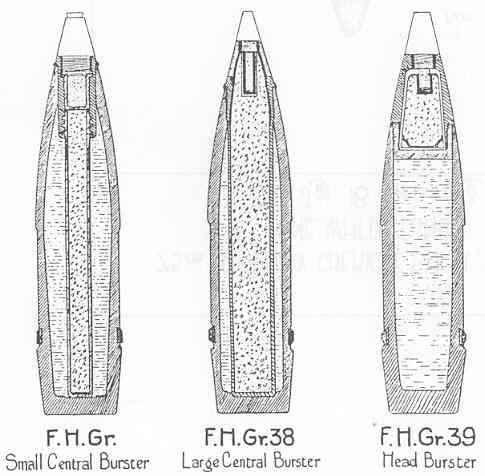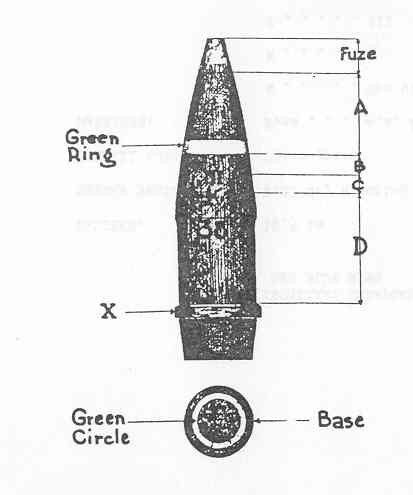| GERMAN CHEMICAL WARFARE MATERIAL |
| Part I - GROUND WEAPONS AND AMMUNITION |
| Section B - ARTILLERY CHEMICAL WARFARE AMMUNITION |
|
INTODUCTION |
|
A scheme has been devised for the destignation of significant identification markings on artillery chemical ammunition by dividing the shell into six areas, namely: fuze, A, B, C, D and base. The areas designated by the letters "A" to "D" are not fixed because the stencilled markings on artillery shell have only approximate locations. The colored rings occasionally found just above the driving band (X) and at the top of section (A) are omitted because they have no chemical identification value; the latter ring and also the colored area around the filling plugs consist of detector paint. Markings on the base may be either stencilled with paint or attached in the form of a gummed label. |
|
The length of the artillery shell (fuze included) does not include the cartridge case. In describing fixed shell, if the length of the shell includes the cartridge case, the fact will be specifically stated. |
|
The Roman numeral stencilled in black in areas "B" or "C" refers to the "Gewichtsklas-se" (weight class) and is not pertinent to the chemical filling; it may vary on shells of the same type. The nomenclature system used in this book and the corresponding German names are as follows: |
| Nomenclature | German Name | |
| Blue Ring One | Blauring 1 (Blauring) | |
| Blue Ring Two | Blauring 2 | |
| Blue Ring Three | Blauring 3 | |
| One Yellow Ring | Gelbring | |
| Green Ring One | Grünring 1 | |
| One Green Ring | Grünring | |
| Green Ring Three | Grünring 3 | |
| One White Ring | Weissring | |
| Green Ring-Yellow | Grünring-Gelb |
|
Associated with the colored rings may be the numbers 1, 2 or 3, or the numbers may be absent entirely. In the single case of "Green Ring-Yellow", two color rings are used on the same munition with the yellow ring being half the width of the green ring. Nine types of shell fillings have been encountered which are indicated by the ring and the numeral code: |
| One Yellow Ring | Mustard (small burster) | |
| One Green Ring | Mustard (medium burster) | |
| Green Ring-Yellow | Mustard (large burster) | |
| Green Ring One | Nitrogen Mustard | |
| Green Ring Three | Green Ring Three agent | |
| Blue Ring One | HE/DM | |
| Blue Ring Two | Arsenöl | |
| Blue Ring Three | DM Generator (base ejection) | |
| One White Ring | HE/CN |
|
There also appears on a shell body stencilled lettering which indicates the ex-act type of chemical filling. The lettering codes is as follows: |
| A | CN | |
| B | Thiodiglycol Mustard/Arsenöl, 1:1 (Winterlost) | |
| C | Thiodiglycol Mustard/Chlorobenzene, 4:1 (Winterlost) | |
| D | Thickened Mustard, made from "B" | |
| E | Thickened Mustard, made from mixture of mustard homologues | |
| F | Phosgene | |
| G | Green Ring Three agent | |
| GA | Green Ring Three agent/Chlorobenzene, 4:1 | |
| H | Diphosgene | |
| K | Nitrogen Mustard | |
| L | Thiodiglycol Mustard/Anthracenöl, 2:1 (Winterlost) | |
| M | DM or DM/DA | |
| N | DA/Arsenöl, 2:3 | |
| O | Thiodiglycol Mustard (Sommerlost) | |
| P | Hydrogen Cyanide |
| Some of the other markings are as follows: |
| Gb | Gelbring (yellow ring) | |
| G/B | Geländebelagerung/B (Ground contamination/Winterlost) | |
| L/O | Luftkampfstoff/O (Cloud gas/Mustard) |
|
The number "38" or the letters "wKh" found on rocket and artillery projectiles refer to the large burster type. The number "39" refers to the head burster. The 15 cm shell, type 19, have small central bursters. The variation in burster types in artillery chemical shell therefore exists in both the 10.5 cm and 15 cm caliber; the following drawings illus-trate the burster types in 10.5 cm shell and the shell markings in the 7.5 cm, 10.5 cm and 15 cm calibers. |
|
I–B |
| 15 cm ARTILLERY CHEMICAL SHELL, TYPE 19 |
| ONE BLUE RING |
| 15 cm Gr. 19 Blauring |
 |
|
I–B |
| Burster Types |
| in |
| 10.5 cm Artillery Chemical Shell |
 |
|
I–B |
| 7.5 cm ARTILLERY CHEMICAL SHELL, TYPE 18 |
| ONE WHITE RING |
| 7.5 cm Jgr. 18 Weissring |
 |
|
I–B |
| 10.5 cm ARTILLERY CHEMICAL SHELL, TYPE 38 |
| GREEN RING ONE |
| 10.5 cm F.H.Gr. 38 Grünring 1 |
 |